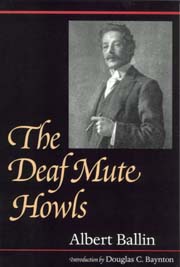Albert Ballin
Introduction by Douglas C. Baynton
| Table of contents Excerpt |
$24.00 paperback, ebook |
Gallaudet Classics in Deaf Studies, Volume 1
“Albert Ballin’s greatest ambition was that The Deaf Mute Howls would transform education for deaf children and more, the relations between deaf and hearing people everywhere. While his primary concern was to improve the lot of the deaf person ‘shunned and isolated as a useless member of society,’ his ambitions were larger yet. He sought to make sign language universally known among both hearing and deaf. He believed that would be the great ‘Remedy,’ as he called it, for the ills that afflicted deaf people in the world, and would vastly enrich the lives of hearing people as well.”
Originally published in 1930, The Deaf Mute Howls flew in the face of the accepted practice of teaching deaf children to speak and read lips while prohibiting the use of sign language. The sharp observations in Albert Ballin’s remarkable book detail his experiences (and those of others) at a late 19th-century residential school for deaf students and his frustrations as an adult seeking acceptance in the majority hearing society.
The Deaf Mute Howls charts the ambiguous attitudes of deaf people toward themselves at this time. Ballin himself makes matter-of-fact use of terms now considered disparaging, such as “deaf-mute,” and he frequently rues the “atrophying” of the parts of his brain necessary for language acquisition. At the same time, he rails against the loss of opportunity for deaf people, and he commandingly shifts the burden of blame to hearing people unwilling to learn the “Universal Sign Language,” his solution to the communication problems of society. From his lively encounters with Alexander Graham Bell (whose desire to close residential schools he surprisingly supports), to his enthrallment with the film industry, Ballin’s highly readable book offers an appealing look at the deaf world during his richly colored lifetime.
Albert Ballin (1867-1933) worked as a fine artist, a lithographer, and as an actor in silent-era films. He died in 1933.
Paperback
ISBN 978-1-56368-073-1
136 pages. 6 x 9. photographs.
$24.00
Ebook
ISBN 978-1-56368-200-1
$24.00
